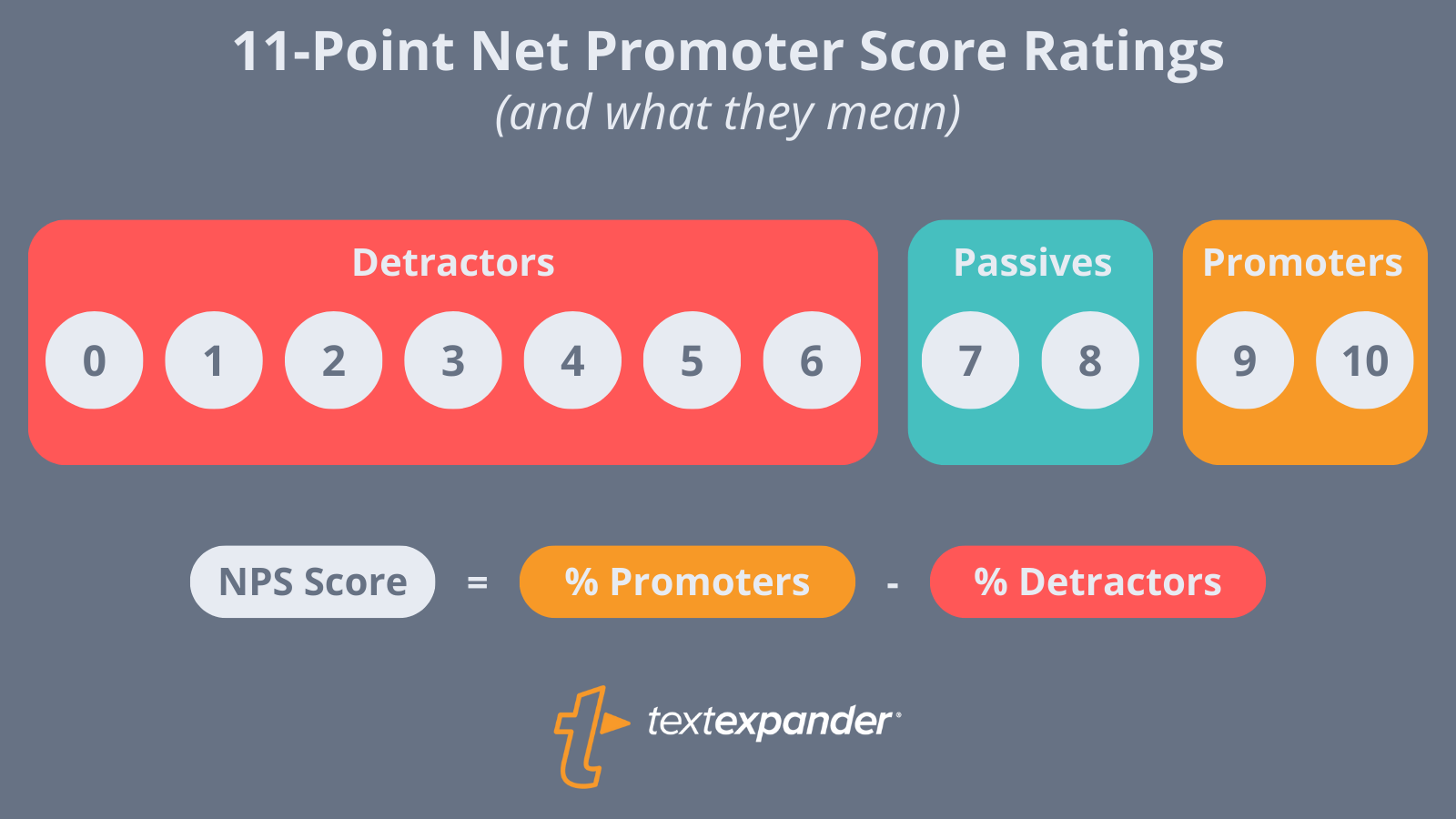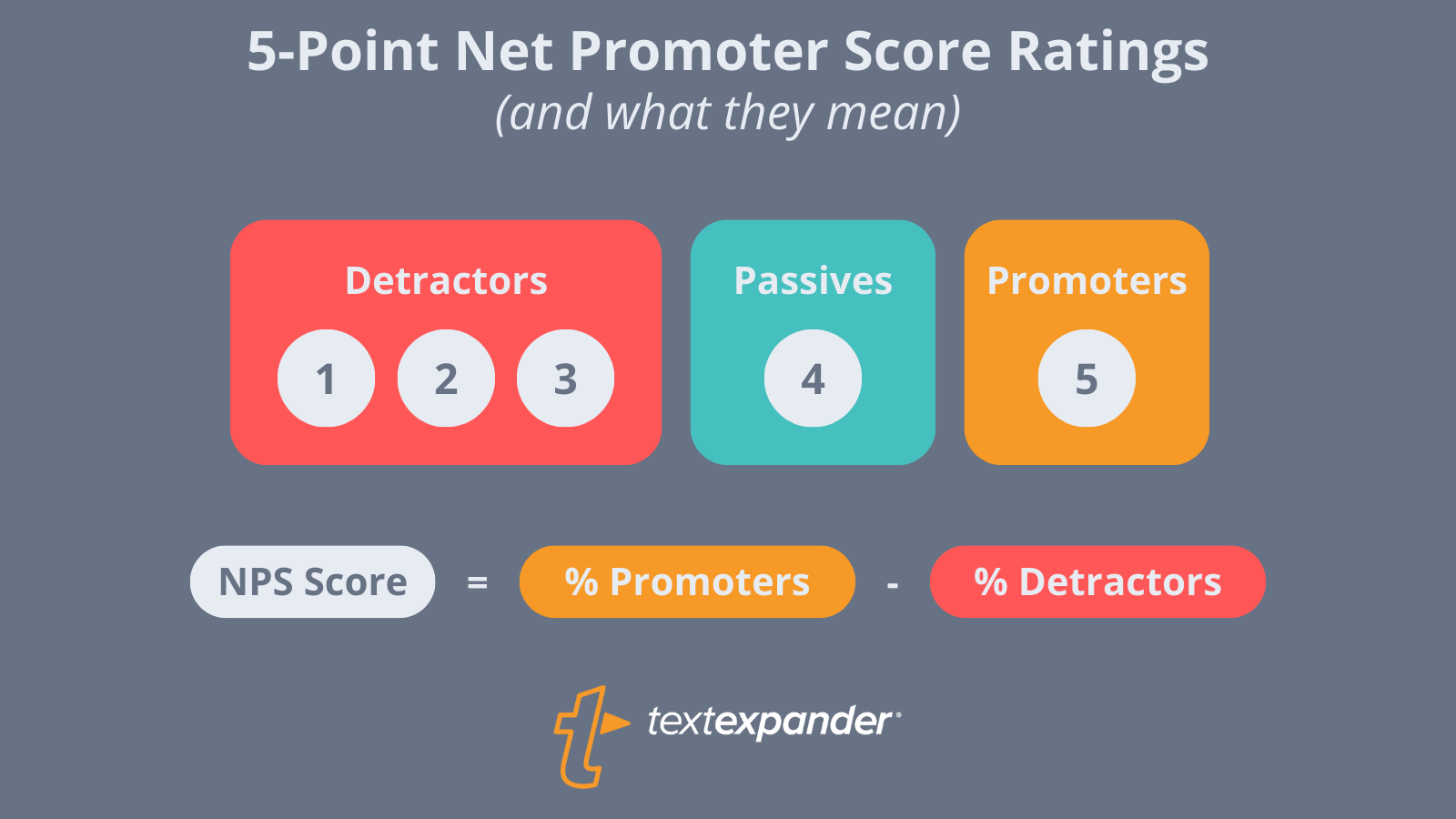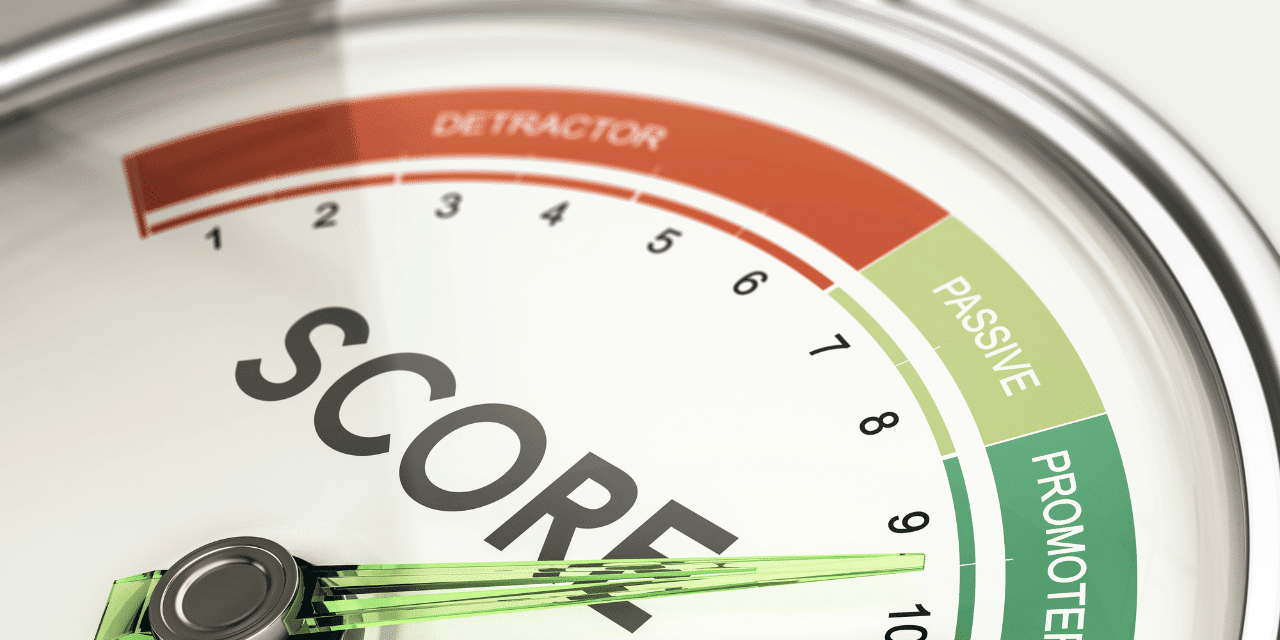How to calculate NPS is a critical task for customer service professionals who live and die based on those survey results. Your NPS score holds significant weight in gauging customer loyalty and satisfaction, and it’s a valuable instrument that can offer key insights into your customer base and health. It’s one of the key customer service stats.
NPS represents the loyalty that motivates customers to become brand ambassadors and share your company’s products/services with others, ultimately driving new business.
So if you’re ready to delve into the world of NPS, learn how to calculate it, interpret it, and use it to drive your business forward, let’s get started!
How Is NPS Calculated? A Simple Explanation

Conduct an NPS Survey
To calculate NPS, you need to survey your customers and ask them a straightforward question:
“How likely are you to recommend our company/product/service to a friend or colleague?”
Their responses will be the building blocks of your NPS score. The survey should be short and simple to reduce friction and increase survey responses.

The industry standard NPS survey is on an 11-point scale from 0 to 10. The 11-point scale is the original method to calculate NPS as envisioned by its inventor, Fred Reichheld.
Sort NPS Survey Results
Once you’ve gathered your answers, it’s time to sort them. The responses are split into three groups:
- Detractors (0-6): The customers who aren’t pleased may risk your brand by spreading negative reviews.
- Passives (7-8): Content but not overly excited customers who other options may tempt.
- Promoters (9-10): Devoted fans who will continue buying and recommending other people, contributing to expansion.

To maintain a loyal customer base and ensure their satisfaction, it is crucial to drive improvements and gather customer feedback continually. The ability to accurately determine NPS provides more than just a starting point. A business owner can gain valuable customer insights by consistently gathering this information. This data allows for confident and informed decision-making. Even if revenue is up today, a bad NPS score can tell you that rocky times are ahead.
The NPS calculation formula
By dividing the overall number of respondents, you can determine the percentage of both Detractors and Promoters, which is necessary to calculate a Net Promoter Score (NPS). After multiplying this result by 100, the percentage can be converted into a final number.
Here are the steps:
- You need to find the percentage of Detractors and the percentage of Promoters. Passives are ignored.
- Calculate the percentage of Detractors: (Number of Detractors / Total NPS Survey Respondents) * 100
- Calculate the percentage of Promoters: (Number of Promoters / Total NPS Survey Respondents) * 100
Calculate your NPS by subtracting the percentage of Detractors from the percentage of Promoters. The resulting number will be your NPS and can range from -100 (if all customers are Detractors) to 100 (if all customers are Promoters).
Net Promoter Score = Percentage of Promoters – Percentage of Detractors
Here’s a handy NPS calculator that makes it easy:
NPS Calculator
Number of responses
who rated you
9 or 10
Number of responses
who rated you
7 or 8
Number of responses
who rated you a
6 or below
How to calculate NPS on a 5-point scale
The 11-point NPS scale is the industry standard. However, some organizations shorten it to a 5-point scale. This compact and popular scale is commonly used because of its simplicity, especially in mobile surveys.
Regardless of which scale you use, it’s important to remain consistent. If you use an 11-point scale, don’t suddenly switch to a 5-point NPS scale and vice versa.
When transitioning from the typical 11-point scale to a 5-point scale, the classification of participants as Detractors, Passives, and Promoters changes.
Detractors are respondents with scores of 1-3 on the simplified 5-point scale. This makes it easy for them to determine their rating. Passive respondents have a score of 4, while Promoters rate themselves a 5.
The calculation formula remains stable despite the scale utilized, which is:
NPS = % Promoters – % Detractors

To calculate NPS on a 5-point scale, you would follow the same steps as with the 11-point scale:
- Categorize the responses into Detractors, Passives, and Promoters.
- Calculate the percentage of Detractors and Promoters by dividing the number of respondents in each category by the total number of respondents and multiplying by 100.
- Subtract the percentage of Detractors from the percentage of Promoters to get your NPS score.
NPS calculation examples
Let’s bring the concept of how to calculate NPS to life with some easy-to-follow NPS calculation examples.
NPS calculation example: 11-Point scale
Let’s say you’ve surveyed 100 customers and received the following feedback:
- 60 customers gave a score of 9 or 10 (Promoters)
- 20 customers gave a score of 7 or 8 (Passives)
- 20 customers gave a score of 0 to 6 (Detractors)
First, calculate the percentage of Promoters and Detractors:
- % Promoters = (60/100) * 100 = 60%
- % Detractors = (20/100) * 100 = 20%
Then, subtract the percentage of Detractors from the percentage of Promoters to get your NPS:
60% Promoters – 20% Detractors = 40 NPS
NPS calculation example: 5-Point scale
Now, let’s consider a 5-point scale with 100 responses:
- 50 customers gave a score of 5 (Promoters)
- 30 customers gave a score of 4 (Passives)
- 20 customers gave a score of 1 to 3 (Detractors)
Again, calculate the percentage of Promoters and Detractors:
- % Promoters = (50/100) * 100 = 50%
- % Detractors = (20/100) * 100 = 20%
Then, calculate the NPS score:
50% Promoters = 20% Detractors = 30 NPS
So, your NPS score is 30.
These examples show how to calculate NPS using both an 11-point and a 5-point scale. Remember, the NPS survey is a great tool for understanding customer loyalty and satisfaction. But the real value lies in using this metric to gain insights into your customer base and make informed decisions to improve customer satisfaction and loyalty. So, keep asking, keep calculating, and keep improving your business. The NPS score can be your lighthouse to growing your business.
How to calculate your NPS score in Excel
If you’re a fan of spreadsheets, you’ll be pleased to know that you can calculate your NPS score using Excel. It’s a straightforward process that can make analyzing your customer survey data a breeze. Let’s walk through the steps.
Step 1: Gather and input survey data
First, you’ll need to input your survey data into Excel. Let’s assume you have a column of survey responses ranging from 0 to 10 (or 1 to 5 if you use a 5-point scale).
Step 2: Categorize responses
Next, you must categorize the responses into Detractors, Passives, and Promoters. You can use the IF function in Excel to do this. For an 11-point scale, the formula would be `=IF(A2<=6, “Detractor”, IF(A2<=8, “Passive”, “Promoter”))`. For a 5-point scale, adjust the formula to `=IF(A2<=3, “Detractor”, IF(A2=4, “Passive”, “Promoter”))`.
Step 3: Calculate the percentages
Use the COUNTIF function to divide the total number of responses by the number of each category you have calculated. For instance, if you have 100 responses and your categories are in column B, the formula to determine the percentage of Promoters would be `=COUNTIF(B2:B101, “Promoter”)/100`. Once you’ve sorted all the responses, you can easily ascertain the percentage of Detractors and Promoters.
Step 4: Calculate NPS
Subtract the percentage of Defenders from the percentage of Supporters to calculate the NPS. It’s important to ensure the cell is formatted as a percentage—otherwise, it won’t look right.
NPS calculators
While Excel is a great tool for calculating your NPS score, a variety of online calculators and apps can simplify the process even further – especially if you need to work with other folks on your team to look at the data. Here are a few tools you might find useful:
- Delighted’s NPS Calculator: This online tool calculates your NPS and provides insights into how your score compares to industry benchmarks. SurveyMonkey’s NPS Calculator: SurveyMonkey offers a comprehensive NPS calculator as part of its suite of survey tools. It’s a great option if you’re already using SurveyMonkey for your customer surveys.
- HubSpot’s NPS Software: If you’re looking for a tool that integrates with your CRM, HubSpot’s NPS software could be a good fit. It allows you to track NPS over time, segment by customer group, and more.
- Retently’s NPS Software: Retently provides a simple and intuitive platform for sending NPS surveys, analyzing responses, and improving customer loyalty
- TextExpander’s NPS calculator: A simple and free tool to quickly calculate NPS.
Remember, the key to leveraging NPS is not just knowing how to calculate it, but understanding what the score means for your business and how to act on it. These tools can help you do that.
Wrap-up: what is a good NPS score?

What is a good NPS score? Short answer: it depends. However, a good NPS score is considered above 0, meaning more Promoters than Detractors, which is always a positive sign.
As with many aspects of business, the answer isn’t always easy to understand. World-class NPS scores above 70 are excellent and can vary widely depending on industry, region, and other factors.
In your quest to harness the potential of NPS, don’t overlook that its true value lies beyond just the numbers. Instead, focus on utilizing that data to propel your customer experience forward. Gain insights from the reasons behind the scores, take action based on customer feedback, and actively work towards converting Detractors into Passives and Passives into Promoters.
So, whether your NPS is -50 or +50, the most important thing is to use it as a tool for growth and as a guide for improving your business, products, and processes.
FAQ About NPS Scores
Q: NPS — what is it?
A: NPS, known as Net Promoter Score, is a metric to gauge customer contentment and dedication. It is determined by asking customers: “How probable is it that you would advise our company/product/service to a friend or colleague, on a scale of 0-10?” The answers received are subsequently classified into three groups: Detractors (0-6 or 1-3 on a 5-point scale), Passives (7-8 or 4 on a 5-point scale), and Promoters (9-10 or 5 on a 5-point scale). The NPS is determined by subtracting the proportion of Detractors from the proportion of Promoters.
Q: How is NPS calculated?
A: The Net Promoter Score (NPS) is calculated by subtracting the percentage of detractors from the percentage of promoters. NPS is calculated based on a survey question that asks customers how likely they are to recommend a product or service to a friend or colleague. The responses are typically categorized into promoters, passives, and detractors. Promoters are considered highly likely to recommend, passives are neutral, and detractors are unlikely to recommend. To calculate NPS, the percentage of detractors is subtracted from the percentage of promoters. The resulting score can range from -100 to +100, with higher scores indicating higher levels of customer advocacy.
If every customer is a Promoter, the NPS score can reach 100. To calculate the NPS, subtract the percentage of Detractors from the percentage of Promoters. The score can range from -100 (if every customer is a Detractor) to 100.
Q: What is a good NPS score?
A world-class NPS score is considered above 70, while above 50 is excellent, and above 0 is generally good. Keep in mind that a good NPS score can vary due to factors like industry and region.
Improving your NPS score is an important goal for many businesses. Here are some tips to help you achieve this:
- Focus on providing exceptional customer service and improving call center metrics. Ensure that your employees are well-trained and capable of delivering a positive customer experience.
- Actively listen to your customers’ feedback and act on it. Implement changes based on their suggestions and address any concerns or issues they may have.
- Personalize the customer experience by understanding their needs and preferences. Customize your products or services to meet their specific requirements.
- Reward and retain loyal customers by offering exclusive deals or promotions.
- Regularly monitor and track your NPS score to measure your progress and identify areas for improvement. By following these strategies, you can boost your NPS score and cultivate strong customer relationships
Improving your NPS score requires analyzing the reasoning behind it, taking action on customer feedback, and working towards converting Detractors into Passives and Passives into Promoters. The key is to make enhancements to your customer experience by utilizing the feedback you gather.
Free sample NPS survey: how to calculate NPS
You might consider using voice of the customer tools to distribute your NPS survey. Here’s a sample below that is a good starting point
On a scale of 0 to 10, with 0 being “Not at all likely” and 10 being “Extremely likely,” please indicate how likely you would be to recommend our services to others.
1. How likely are you to recommend our products/services to others?
2. Please share the reasons behind your rating. Your feedback will help us understand what aspects we do well at and what areas need improvement.
3. Are there specific features or services that stand out to you as particularly positive or valuable as a customer?
4 Are there any aspects of our products/services that you believe need improvement? If so, please provide details.
5. How satisfied are you with our customer support team?
6. If you encountered any challenges while using our services, did our team adequately address and resolve them to your satisfaction?
7. How likely are you to continue using our services in the future?
8. Do you have any additional comments, suggestions, or ideas for us to consider as we aim to improve our services?




